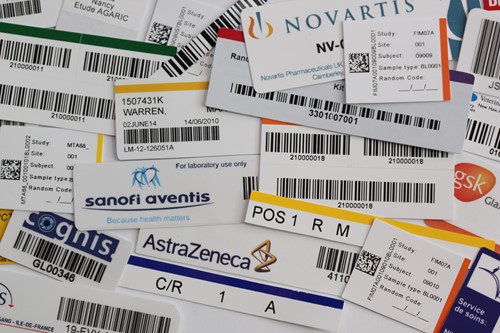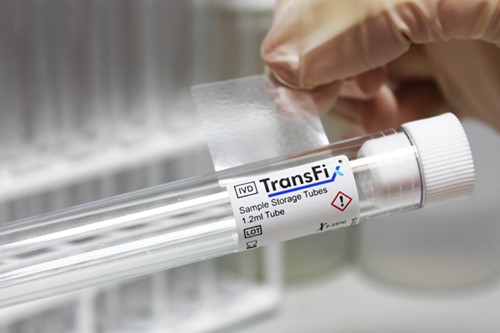3 Common Mistakes in Laboratory Labelling and how to solve them

Why proper labelling is essential in your laboratory?
A key aspect of laboratory best practice is to ensure the labelling processes are up to scratch and that you are using the correct labels for your study or research lab.
This may seem like an obvious point and easy task to get right, however, from our experience labels are often thought about last but can have a dramatic impact on a project if not correctly matched up to the end-use.
This can jeopardize projects, cost money and waste time.
1. Using the wrong label for the end application
Label technology has become very sophisticated, with many adhesive, material and ribbon combinations to choose from. This can make it tricky for labs to know exactly what label is right for their requirements.
Selecting a label that isn’t matched correctly to the end application has the potential to invalidate a study or project a laboratory is working on.
Here is a list of questions to ask yourself when buying or testing your laboratory labels:
- Do the labels you use or are testing perform as desired and stick to the surface they need to for the time needed? For example, frozen vials will need a tube label that can adhere to a frozen surface.
- Does the label do what it’s intended to do visually? Are the markings clear, if it’s a self-laminating label does the tail wrap around correctly and cover all the print.
- Is the label durable enough to withstand the processes and environment it’s going to be put through in a lab? Can it resist high temperatures, chemicals, solvents, liquid nitrogen etc.
- Is the print clear and not fading? This is important to note and the right combination of material, adhesive, ribbon and printer must be used for optimal results.
- How long does the label need to last? This may vary depending on the laboratory application, this may only be a short time or need to last for years.
We have over 30 years labelling experience and our specialists are very well equipped to help guide you through the labelling process and ask you the correct qualifying questions to ensure you get the right label first time. Get in touch!
2. Handwritten Labels
Even with all the technological innovations and advancements within the labelling industry, there is still a large proportion of laboratories that handwrite their data onto handwritten labels.
Although there is nothing wrong with this approach, as it is quick and easy to pick up a pen/pencil and has the benefit of anyone being able to do it, there are also numerous downsides.
Handwritten labels can be extremely difficult to read, as such have the tendency to become unreliable. There is potential for ink/pencil to smear, making it easy to misread the information on the label which can cause repetitive errors.

CILS has many years’ experience helping labs upgrade their labels and labelling systems to improve efficiencies, save money and reduce errors. Fortunately, there are affordable print systems available that can be set-up easily and quickly without a steep learning that will fulfill all basic labelling requirements.
CILS computer imprintable labelling systems start from as little as £360.00 including labelling software which will provide the capabilities to print the kind of durable labels most laboratories need and use. We have a dedicated team of labelling specialists who can walk you through the set-up process in person or by video chat.

Computer imprintable labels provide considerably more benefits over handwritten labels such as:
- Quick and easy to print allowing you to print in large batches or single labels at a time.
- A more efficient way of inputting data onto labels rather than manually handwriting on each label saving time that can be used in a more productive way.
- The print quality is clear and very legible meaning it is more reliable for the whole lab team to be able to identify samples and not just the laboratory technician who would normally handwrite the information.
- The labels and variable data printed on them is durable, so they are able to resist chemicals, solvents, harsh laboratory environments and much more.
- Minimize errors and reduce the time needed to interpret information, making it much more accurate and removing the need to rewrite correct information which is always a risk with handwritten samples.

If you are looking to upgrade your laboratory labelling and want to explore computer imprintable labels further, then please get in touch and one of our technical labelling specialists will be happy to help.
3. Handling of labels
A common issue in laboratory labelling is that the labels themselves are not applied correctly to the surface of the application they are used for and due to poor handling, the adhesive might be rendered ineffective.
How you handle a label can have a dramatic impact on how effectively it will stick to a surface. This is particularly true if you are wearing powdered latex gloves.
As such, it is highly recommended that the label is handled as little as possible from the moment you peel it off the release liner to when it is stuck onto the desired surface.
Minimizing the amount of contact the adhesive side of the label has with skin or gloves will provide the best chance for the adhesive to bond to the surface it is being stuck to so the label can perform its purpose.
If not handled correctly, this could cause the label to fall off and compromise your project.

How CILS can help you with your labelling strategy
Implementing the correct labelling strategy may seem daunting at first but it doesn’t have to be. With the right help and guidance from a team of specialists, we can make it a smooth effortless process.
Labels are a powerful tool to help provide laboratory identification and tracking solutions for your lab. They can help you reduce errors, improve your data accuracy, reduce errors and overall make the process more efficient.
As labelling solutions get smarter and more advanced, no doubt more laboratories are going to be investing in these solutions to help with their sample identification needs.
Now is a great time to implement an efficient full labelling system that is future proof and will enable you to effectively manage the integrity of your data and sample tracking saving you time, money and reduce errors.
Talk to a specialist today and see how we can help you with your laboratory labelling.